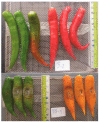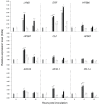Expression of Genes Involved in Anthracnose Resistance in Chili (Capsicum baccatum) 'PBC80'-Derived Recombinant Inbred Lines
- PMID: 38003772
- PMCID: PMC10675817
- DOI: 10.3390/pathogens12111306
Expression of Genes Involved in Anthracnose Resistance in Chili (Capsicum baccatum) 'PBC80'-Derived Recombinant Inbred Lines
Abstract
Chili anthracnose has long been a threat to chili production worldwide. Capsicum baccatum 'PBC80' has been identified as a source of resistance to anthracnose. Recently, a QTL for ripe fruit resistance from 'PBC80'-derived RILs was located on chromosome 4 (123 Mb) and contained over 80 defense-related genes. To identify the genes most related to anthracnose resistance, a fine map of the QTL region was developed using single-marker analysis. Nine genes were selected from the new QTL (1.12 Mb) to study their expression after being challenged with Colletotrichum scovillei 'MJ5' in two different RIL genotypes (Resistance/Resistance or R/R and Susceptible/Susceptible or S/S) at 0, 6 and 12 h. Of the nine genes, LYM2, CQW23_09597, CLF, NFXL1, and PR-14 were significantly up-regulated, compared to the control, in the R/R genotype. ERF was up-regulated in both chili genotypes. However, the expression was relatively and constantly low in the S/S genotype. Most up-regulated genes reached the highest peak (2.3-4.5 fold) at 6 h, except for ERF, which had the highest peak at 12 h (6.4 fold). The earliest and highest expressed gene was a pathogen receptor, LYM2.
Keywords: Colletotrichum scovillei; defense-related genes; hypersensitive reaction; microinjection; qRT-PCR; wounded inoculation.
Conflict of interest statement
The authors declare no conflict of interest.
Figures





Similar articles
-
Differential resistances to anthracnose in Capsicum baccatum as responding to two Colletotrichum pathotypes and inoculation methods.Breed Sci. 2013 Sep;63(3):333-8. doi: 10.1270/jsbbs.63.333. Epub 2013 Sep 1. Breed Sci. 2013. PMID: 24273429 Free PMC article.
-
The Capsicum baccatum-Specific Truncated NLR Protein CbCN Enhances the Innate Immunity against Colletotrichum acutatum.Int J Mol Sci. 2021 Jul 18;22(14):7672. doi: 10.3390/ijms22147672. Int J Mol Sci. 2021. PMID: 34299290 Free PMC article.
-
Identification of two new genes conferring resistance to Colletotrichum acutatum in Capsicum baccatum.Phytopathology. 2009 Sep;99(9):1100-4. doi: 10.1094/PHYTO-99-9-1100. Phytopathology. 2009. PMID: 19671013
-
Breeding for Anthracnose Disease Resistance in Chili: Progress and Prospects.Int J Mol Sci. 2018 Oct 11;19(10):3122. doi: 10.3390/ijms19103122. Int J Mol Sci. 2018. PMID: 30314374 Free PMC article. Review.
-
Final report on the safety assessment of capsicum annuum extract, capsicum annuum fruit extract, capsicum annuum resin, capsicum annuum fruit powder, capsicum frutescens fruit, capsicum frutescens fruit extract, capsicum frutescens resin, and capsaicin.Int J Toxicol. 2007;26 Suppl 1:3-106. doi: 10.1080/10915810601163939. Int J Toxicol. 2007. PMID: 17365137 Review.
References
-
- Mongkolporn O. Capsicum: Breeding Strategies for Anthracnose Resistance. CRC Press; Boca Raton, FL, USA: 2018.
-
- Mongkolporn O., Taylor P.W.J. Chili anthracnose: Colletotrichum taxonomy and pathogenicity. Plant Pathol. 2018;67:1255–1263. doi: 10.1111/ppa.12850. - DOI
LinkOut - more resources
Full Text Sources
Research Materials
Miscellaneous

